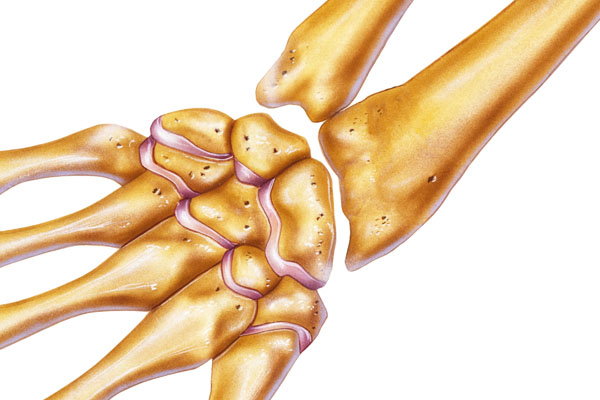| What is a Wrist Fracture?22 August 2017 | Eugene The wrist is made up of an exceedingly complex network of interconnected bones and ligaments, allowing us a near endless range of motions in our hands and forearms. When this area becomes damaged, it's no wonder that diagnoses can sometimes be tricky, as there are a multitude of different ways the wrist can be injured. At WristSupports.co.uk, we're committed to educating our customers about their wrists, and helping them to choose the best supports and braces to help them heal. In this article, we'll tackle the Wrist Fracture. What is a Wrist Fracture?A Wrist Fracture is simply a medical term for a broken wrist, but, when it comes to specific classification of the injury, things become less simple. This is because the wrist is made up of eight small bones, which connect to the two bones of the forearm: the ulna (little-finger side) and radius (thumb side). A Wrist Fracture occurs when any of these ten bones becomes broken, of which the most common to break is to the radius. Symptoms, causes and treatments of Wrist Fractures depend on which bone is broken, and the severity of the break. In general, Wrist Fractures are split into five categories:
Types of Wrist FractureWhile the severity of a Wrist Fracture is a primary aspect of diagnosis, just as important is the area affected. Since there are eight carpal bones in the wrist, and two forearm bones, there are quite a few types of Wrist Fracture that can occur. Some of the most common include:
The complex bones that make up the wrist How to Tell a Break from a Sprain?One of the most common misdiagnoses of a Wrist Fracture is as a wrist sprain, and vice versa. This is because the two share a large number of symptoms in common, but require different treatments. In most cases, proper diagnosis will require an x-ray by your physician, but it's helpful to know the signs of each for proper first aid after injury. We've put together a few of the most reliable ways to tell before you reach the doctor's office:
Treatment of a Wrist FractureAs has been mentioned above, treatment of your Wrist Fracture will depend both on the severity of the break, and the bones of the wrist involved. They can also depend on the types of activities you need to carry out, and your general health at the time. Most commonly, treatment depends on whether the fracture is stable, where the bones can reliably be set back in position, or unstable, where the bones are prone to shifting. Unstable FracturesThis type of Wrist Fracture is usually more complex, and may require surgery. If a splint or cast is placed without surgery, the bones can often shift out of position, leading to risks of further injury, or the bone healing crookedly. Stable FracturesThese Wrist Fractures can usually be treated more easily. In some cases, minor repositioning must be done, known as a "closed reduction", in which the bone can be positioned without surgery. After that, an immobilising splint should be used in order to allow the area to rest and reduce the risk of reaggravation of the injury. This splinting is usually combined with the use of anti-inflammatory medication, along with physical therapy to rehabilitate the muscles and ligaments of the wrist. Which Wrist Support Should I Choose?Once your Wrist Fracture has been reset in the proper position by your physician, the next step is immobilisation. If you and your doctor decide a splint is sufficient instead of a cast, a sturdy splint that protects the area while providing immobilisation in key. Preventing movement in the area will protect your bones and ligaments from further damage, allowing the area to heal. Here at Wrist Supports, we stock a full range of splints and supports for most types of Wrist Fractures, with varying levels of support and protection. To take a look at our entire range of wrist supports, splints and braces for Wrist Fractures, click the yellow button below. Do you have a question to ask or something to add? Why not leave us a comment below or find us on Facebook or Twitter. |
FREE UK DELIVERYon orders of £40 and over. EXPERT CUSTOMER SUPPORTRead our reviews. EASY PRODUCT RETURNSwith our 30 day returns policy. |

